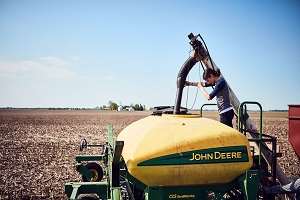Soy checkoff encourages farmers to consider demand when choosing varieties

The U.S. soybean industry has a track record of achieving higher yields, creating and expanding markets and ultimately driving profitability. As a next step, the soy checkoff is encouraging soybean farmers to use the same balanced approach they take to their farms and land to anticipate and meet market needs.
Yield will always be important, but balancing the focus between the number of bushels produced and how well those bushels meet end-user demands will help ensure there is a strong market for soybeans in the future.
For farmers, maximizing yield potential while also meeting the protein, oil and sustainability demands of customers starts with seed selection.
“Variety selection is far and away the No. 1 decision a grower has to make,” says Shawn Conley, Ph.D., state soybean and small grains specialist, University of Wisconsin-Madison.
Seed selection not only has a direct impact on yield. It also influences value and demand.
Seed selection can help farmers battle competitive threats
Farmers make critical seed decisions in an effort to increase their bottom line. Paying attention to end-user demands, and planting soybeans with traits to meet those demands, keeps customers happy and profitability high.
End users, like poultry and livestock producers and food companies, choose soybean meal and oil for the nutritional and functionality benefits they offer. However, competitive forces, like ingredients from other crops and other countries, are putting pressure on the soybean industry to offer customers even better products.
The checkoff funds research to provide farmers with the very best soybean varieties. But U.S. farmers are the ones to bring these improved soybeans – with improved meal and oil components – to fruition to meet customer needs.
When both parts of this equation come together, exciting new opportunities emerge. High oleic soybeans are a prime example.
When trans fats became an issue and soybean oil market share declined, the industry responded with high oleic soybean varieties. By partnering with the industry, the checkoff helped drive these innovative varieties that are helping farmers regain demand lost to other competitive oil sources. And because high oleic is an enhanced oil that’s in greater demand, processors offer a premium to farmers for growing it.
“As farmers, we need to look at all opportunities to maximize profits,” says Indiana farmer Al Osterlund, who has planted high oleic varieties the past two years. “It’s a no-brainer. That additional premium is huge, and there isn’t any special treatment other than segregating.”
By simply choosing to plant high oleic soybeans, farmers can meet new demand and address competitive forces. But they can’t do it alone.
The high oleic initiative shows it takes a collaborative effort that includes the checkoff, seed-technology companies, processors and more.
Meeting end-user demand with high-protein seed and enhanced meal traits
Just like farmers are fighting off a competitive threat from trans fats, they have an opportunity to overcome another obstacle through seed selection.
Poultry and livestock farmers require high levels of protein to maximize their animals’ potential. With additional options available, such as canola meal and DDGs, it’s crucial for soybean farmers to consider their end users’ needs when selecting seed.
While many soybean farmers think they can’t grow soybeans with the high levels of protein and oil to meet those needs without sacrificing their yield potential, this is not the case.
There are many varieties available that will produce high yields and provide the high levels of protein that end-users desire.
In fact, oftentimes the yield among soybean varieties is relatively consistent, while the levels of protein they produce varies greatly.
“Since we always try to select the highest-yielding soybean varieties, we don’t see a large range in yield in our soybeans,” says Trek Murray, quality traits market manager at Beck’s. “The protein levels in our varieties vary quite a bit, however. They range anywhere from 36 percent protein to some that are pushing 43 percent.”
And to remain the high-quality, high-protein supplier of choice, the checkoff aims to drive success in increasing the value of U.S. soybean meal.
The checkoff funds research to improve the nutritional bundle of U.S. soybean meal for poultry and livestock. One example is a project led by Katy Martin Rainey, Ph.D., at Purdue University, to improve the energy content of soybean meal.
“It’s important for the industry to continually improve its products to meet customer needs,” she says. “Every industry evolves. It’s kind of a ‘chicken and the egg’ scenario – the market may not exist yet, but we still need to develop the products the market will demand.”
Through research and partnerships, the checkoff helps put farmers in a position to gain from meeting customer needs.
Selecting high-quality soybean seeds keeps end users coming back
U.S. soy meets the demand of millions of end users around the globe. To demonstrate
U.S. soy’s benefits, like quality, farmers have the U.S. Soy Advantage.
“We believe that U.S. soy has an edge over other soybeans and protein sources around the world because of its high nutritional value and consistency,” says Fares Hammoudeh, a business leader with the Hammoudeh Group, an agribusiness, food manufacturing and chemical company based in Jordan that specializes in animal feed and poultry processing.
Superior nutritional value and consistency are key factors for poultry and livestock farmers choosing efficient protein sources for their animals. But while U.S. soy has the advantage in this market now, farmers need to commit to continuous improvement to grow demand in the future.
That commitment can be made by selecting high-protein soybean seed varieties.
Click here to see more...